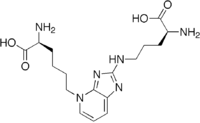Pentosidine
Pentosidine is a biomarker for advanced glycation endproducts, or AGEs. It is a well characterized and easily detected member of this large class of compounds.
 | |
| Names | |
|---|---|
| IUPAC name
(2S)-2-Amino-6-[2-[[(4S)- 4-amino-5-hydroxy-5-oxopentyl]]-4-imidazo [4,5-b]pyridinyl]hexanoic acid | |
| Identifiers | |
3D model (JSmol) |
|
| ChEBI | |
| ChemSpider | |
PubChem CID |
|
| UNII | |
CompTox Dashboard (EPA) |
|
| |
| |
| Properties | |
| C17H26N6O4 | |
| Molar mass | 378.433 g·mol−1 |
| Density | 1.47 g/cm3 |
Except where otherwise noted, data are given for materials in their standard state (at 25 °C [77 °F], 100 kPa). | |
| Infobox references | |
Background
AGEs are biochemicals formed continuously under normal circumstances, but more rapidly under a variety of stresses, especially oxidative stress and hyperglycemia. They serve as markers of stress and act as toxins themselves. Pentosidine is typical of the class, except that it fluoresces, which allows it to be seen and measured easily. Because it is well characterized, it is often studied to provide new insight into the biochemistry of AGE compounds in general.
Biochemistry
Derived from ribose, a pentose, pentosidine forms fluorescent cross-links between the arginine and lysine residues in collagen. It is formed in a reaction of the amino acids with the Maillard reaction products of ribose.[1]
Although it is present only in trace concentrations among tissue proteins, it is useful for assessing cumulative damage to proteins—advanced glycation endproducts—by non-enzymatic browning reactions with carbohydrates.[2][3][4]
Physiology
In vivo, AGEs form pentosidine through sugar fragmentation. In patients with diabetes mellitus type 2, pentosidine correlates with the presence and severity of diabetic complications.[5]
References
- Miyata T, Ueda Y, Horie K, Nangaku M, Tanaka S, van Ypersele de Strihou C, Kurokawa K (1998). "Renal catabolism of advanced glycation end products: The fate of pentosidine" (PDF). Kidney International. 53 (2): 416–422. doi:10.1046/j.1523-1755.1998.00756.x. PMID 9461101.
- DG Dyer; JA Blackledge; SR Thorpe; JW Baynes (Jun 1991). "Formation of pentosidine during nonenzymatic browning of proteins by glucose. Identification of glucose and other carbohydrates as possible precursors of pentosidine in vivo". J. Biol. Chem. 266 (18): 11654–11660. PMID 1904867. Retrieved 2007-12-14.
- Will Boggs. "DHEA Restores Oxidative Balance in Type 2 Diabetes". Medscape. Archived from the original on 2008-01-07. Retrieved 2007-12-14.
- Meerwaldt R, Graaff R, Oomen PH, et al. (2004). "Simple non-invasive assessment of advanced glycation endproduct accumulation". Diabetologia. 47 (7): 1324–30. doi:10.1007/s00125-004-1451-2. PMID 15243705.
- Sell DR, Lapolla A, Odetti P, Fogarty J, Monnier VM (Oct 1992). "Pentosidine formation in skin correlates with severity of complications in individuals with long-standing IDDM". Diabetes. 41 (10): 1286–92. doi:10.2337/diabetes.41.10.1286. PMID 1397702. Archived from the original on 2008-08-07. Retrieved 2007-12-15.